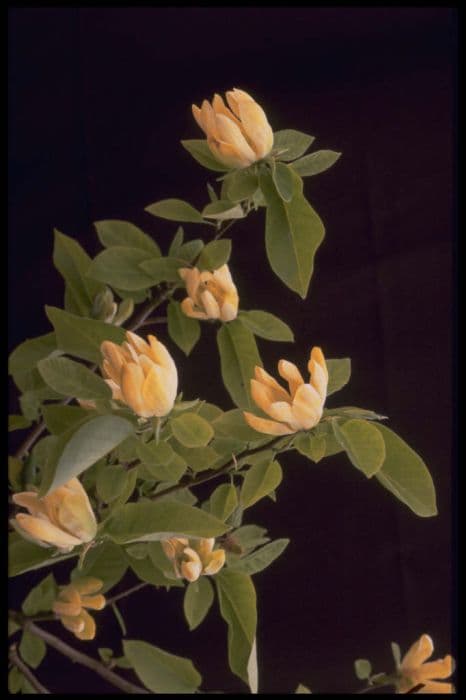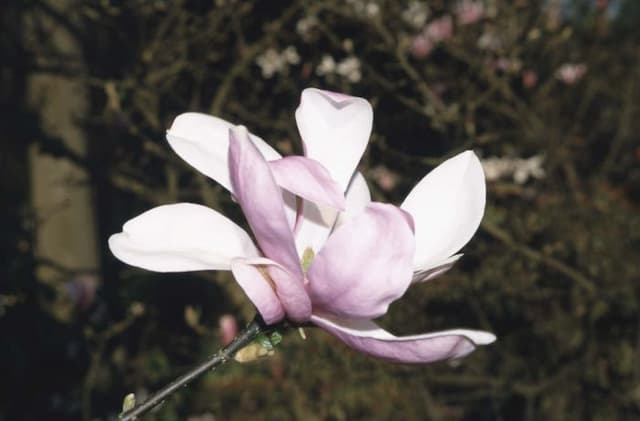Fairy Magnolia Blush Magnolia Fairy Magnolia Blush = 'Micjur01' (PBR)
![magnolia [Fairy Blush]](/_next/image?url=https%3A%2F%2Fplants-admin.emdemapps.com%2Fimages%2Fplants%2F%2Fimages%2F604b5a108e959.png&w=3840&q=75)
ABOUT
The Fairy Magnolia Blush is a beautifully structured plant known for its attractive features and alluring presence in a garden setting. It boasts an abundance of blush-pink flowers that have a delicate, almost translucent quality to them. Each bloom has multiple petals arranged in a layered fashion, exuding a gentle yet stunning effect. These pastel pink flowers emit a sweet fragrance that can be detected wafting through the air, especially in the early morning or late evening. The foliage of the Fairy Magnolia Blush is equally impressive, with glossy green leaves that provide a lush backdrop to the soft pink blossoms. The leaves are elongated, with a smooth surface and a sturdy texture, giving the plant a dense, bushy appearance. As the seasons change, the leaves may take on a slight bronze tinge, adding further visual interest. The plant's branching structure is strong and well-formed, supporting the weight of the flowers and leaves with grace. Branches tend to emerge from the main stem in a way that creates an open yet full silhouette, allowing light to filter through and showcase the blooms and foliage. Overall, the Fairy Magnolia Blush is a captivating specimen that combines form, color, and fragrance to create an enchanting display in any setting where it is planted.
About this plant
 Names
NamesFamily
Magnoliaceae
Synonyms
Fairy Magnolia Blush, Fairy Magnolia
Common names
Magnolia 'Micjur01' (PBR) Fairy Magnolia Blush.
 Toxicity
ToxicityTo humans
Fairy Magnolia Blush is not commonly known to be toxic to humans. There is no specific documented information about its toxicity or the consequences of ingesting this plant. However, as with any plant material, individuals might experience varying reactions, and it's always best to avoid ingesting plant parts that are not explicitly meant for consumption.
To pets
Fairy Magnolia Blush is also not commonly known to be toxic to pets. There isn't widely available information on the plant causing any adverse reactions in animals. While it doesn't have a reputation for being poisonous, it's prudent to prevent pets from ingesting plants not intended for them to ensure their safety.
 Characteristics
CharacteristicsLife cycle
Perennials
Foliage type
Evergreen
Color of leaves
Green
Flower color
Pink
Height
8 feet (2.4 meters)
Spread
4 feet (1.2 meters)
Plant type
Shrub
Hardiness zones
7
Native area
Asia
Benefits
 General Benefits
General Benefits- Ornamental Appeal: Adds visual interest to gardens with its delicate pink blooms.
- Compact Size: Suitable for small gardens or spaces with limited room.
- Spring Blooming: One of the early flowering shrubs, signaling the start of spring.
- Fragrance: The flowers emit a light, pleasant scent that can enhance the sensory experience of a garden.
- Attracts Pollinators: Helps support the local ecosystem by attracting bees and other beneficial insects.
- Low Maintenance: Requires minimal pruning and upkeep once established.
- Drought Resistance: Can tolerate periods of low water once established, making it suitable for xeriscaping.
- Versatility: Can be planted as a standalone specimen or as part of a shrub border.
- Year-Round Interest: The plant has an extended season of interest with its evergreen foliage.
 Medical Properties
Medical PropertiesThis plant is not used for medical purposes.
 Air-purifying Qualities
Air-purifying QualitiesThis plant is not specifically known for air purifying qualities.
 Other Uses
Other Uses- Artistic Inspiration: The Magnolia Fairy Blush's delicate pink blossoms can inspire artists and can be used as subjects in paintings, drawings, and photography.
- Perfumery: The fragrance of Magnolia Fairy Blush flowers can be captured and used in perfumes or scented candles, providing a floral note.
- Educational Tool: Botany students can study the plant's reproductive process or morphology as Magnolia Fairy Blush has distinctive flowers and growth habits.
- Culinary Garnish: Fresh or candied petals can elegantly garnish desserts or cocktails, though care should be taken to ensure they're free of pesticides.
- Craft Material: Dried leaves and flowers can be used in scrapbooking, card making, or as a natural material in various DIY crafts.
- Wedding Decor: Its branches and flowers can be incorporated into wedding bouquets, centerpieces, or venue decorations for a romantic touch.
- Dye Source: The petals and bark may provide natural dyes for textiles or art projects, producing unique and possibly delicate hues.
- Horticultural Training: Pruning Magnolia Fairy Blush plants can serve as an exercise for horticulture students practicing ornamental plant maintenance.
- Mindfulness Practice: Observing and caring for a Magnolia Fairy Blush can be a form of mindfulness practice, promoting relaxation and a connection with nature.
- Natural Playdough Colorant: The pigments from the petals can be used to color homemade playdough for children's craft activities in a non-toxic way.
Interesting Facts
 Feng Shui
Feng ShuiMagnolias are considered symbols of purity and nobility in Feng Shui. This Magnolia can be used to attract positive energy and enhance the sense of balance and love in a home, especially when placed in the southwest area which is related to love and marriage.
 Zodiac Sign Compitability
Zodiac Sign CompitabilityThe Magnolia is not used in astrology practice.
 Plant Symbolism
Plant Symbolism- Nobility: Magnolias are often associated with nobility and dignity due to their impressive appearance and stature.
- Perseverance: They bloom boldly and are resilient in tough growing conditions, which indicates a symbol of perseverance.
- Purity: The pristine and delicate nature of the magnolia blossom is frequently connected with the symbolism of purity and innocence.
- Femininity: With its soft, blush petals, the 'Fairy Magnolia Blush' specifically could be seen as embodying qualities of femininity and gentleness.
- Longevity: As Magnolia trees are known for their long life span, they may symbolize endurance and long-lasting aspects in various cultures.
 Water
WaterFairy Magnolia Blush should be watered deeply to encourage root growth, ensuring even moisture without waterlogging, which can be detrimental. Newly planted specimens require more frequent watering, about once or twice a week, depending on weather conditions, until they are established. Established plants will benefit from watering once every week or two, with each session providing approximately 1 to 1.5 gallons to maintain consistent soil moisture. During hot, dry spells, monitoring the soil moisture is crucial and may necessitate additional watering if the top few inches are dry to the touch.
 Light
LightFairy Magnolia Blush thrives in full sun to partial shade, preferring at least 4 to 6 hours of sunlight each day. The best spot for the plant would provide morning sunlight with some afternoon shade in hotter climates, as too much intense afternoon sun can potentially stress the plant and its blooms.
 Temperature
TemperatureFairy Magnolia Blush can tolerate a range of temperatures but grows best when the climate stays between 55°F and 85°F. It can endure minimum temperatures down to about 20°F, although prolonged exposure to freezing conditions should be avoided. The ideal temperature for encouraging lush growth and vibrant blooms would be in the moderate range, avoiding extremes of either cold or heat.
 Pruning
PruningFairy Magnolia Blush benefits from pruning to shape the plant, encourage new growth, and maintain health. Prune after flowering to avoid cutting off the next year's buds; this is typically in late spring or early summer. Removing dead or crossing branches can be done as needed to improve air circulation and light penetration within the plant.
 Cleaning
CleaningAs needed
 Soil
SoilFairy Magnolia Blush thrives in well-draining, rich, organic soil with a slightly acidic to neutral pH between 5.5 and 7.0. A mix of loamy soil, compost, and pine bark can create an ideal growing medium for this magnolia.
 Repotting
RepottingFairy Magnolia Blush typically does not need frequent repotting and can be repotted every 2 to 3 years, or when you notice the roots are becoming crowded in the pot.
 Humidity & Misting
Humidity & MistingFairy Magnolia Blush prefers moderate humidity levels but can adapt to average household humidity. It is best to avoid extremely low humidity environments to maintain plant health.
 Suitable locations
Suitable locationsIndoor
Place in bright, indirect light and keep soil moist.
Outdoor
Choose a sunny to partial shade spot; shelter from strong winds.
Hardiness zone
7-9 USDA
 Life cycle
Life cycleThe Fairy Magnolia Blush, also known as 'Micjur01', begins its life cycle as a seed, which upon germination in favorable conditions of soil, moisture, and temperature, develops into a seedling. The seedling stage is followed by vegetative growth, where the plant establishes its root system and foliage in the form of lush, green leaves. As it matures, the Fairy Magnolia Blush enters the flowering stage, producing delicate, lightly scented blush-pink flowers that attract pollinators and signify the plant's reproductive phase. Following pollination, the flowers develop into seed pods, setting the stage for seed dispersal. Once seeds are spread, potentially by wind, animals, or human intervention, those that successfully land in conducive environments will germinate, completing the cycle. Throughout its lifetime, which includes a period of dormancy during colder months, the Fairy Magnolia Blush requires appropriate care to thrive, including proper sunlight, watering, and pruning.
 Propogation
PropogationPropogation time
Spring
Propogation: The Magnolia Fairy Magnolia Blush, known as 'Micjur01', is best propagated through softwood cuttings, which is the most popular method. This involves taking a cutting that is about 4 to 6 inches (10 to 15 cm) long from new growth that is not yet hard. The cutting should be made just below a leaf node, and the lower leaves should be removed. The cut end is then treated with a rooting hormone and placed in a pot containing a mix of peat and perlite or a similar medium to encourage root development. The cutting should be kept under high humidity, either with a plastic covering or a humidity dome, and in indirect light. Rooting typically occurs in a few weeks, after which the new Magnolia can be transplanted to a more permanent location.








![Magnolia [Black Tulip]](/_next/image?url=https%3A%2F%2Fplants-admin.emdemapps.com%2Fimages%2Fplants%2F%2Fimages%2F604b590290fc7.png&w=640&q=75)
